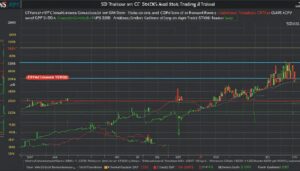Welcome to my comprehensive guide on CFDs on stocks and traditional stock trading. In this article, we will explore the key differences between these two approaches to investing in the stock market. Whether you are a seasoned investor or just starting out, understanding these differences can provide valuable insights into making informed investment decisions.
CFDs, or Contract for Difference, are financial derivatives that allow investors to speculate on the price movement of stocks without owning the underlying asset. On the other hand, traditional stock trading involves buying and owning shares of a company in the hopes of profiting from price appreciation.
One of the main distinctions between CFDs on stocks and traditional stock trading is the use of leverage. With CFDs, traders have the ability to take larger positions with a smaller initial investment. This can potentially lead to larger profits or losses compared to traditional stock trading.
Another key difference is the opportunity to go short. CFDs allow traders to profit from falling prices by selling the contract and buying it back at a lower price. Traditional stock trading, on the other hand, only allows investors to profit from rising prices.
It is important to note that CFDs carry higher risks compared to traditional stock trading. Traders need to be aware of the potential for margin calls and closely monitor their positions to avoid significant losses.
Now that we have established the basic differences between CFDs on stocks and traditional stock trading, let’s delve further into the intricacies of each approach and explore their pros and cons.
Key Takeaways:
- CFDs allow investors to speculate on the price movement of stocks without owning the underlying asset.
- Traditional stock trading involves the purchase and ownership of shares in a company.
- CFDs offer leverage, enabling traders to take larger positions with a smaller initial investment.
- CFDs provide the opportunity to go short and profit from falling prices.
- Traditional stock trading does not involve leverage and only allows investors to profit from rising prices.
- CFDs carry higher risks, including the potential for margin calls and the need for close monitoring of positions.
Understanding CFD Trading
CFD trading is a form of derivative trading where investors speculate on the price movements of various financial instruments, such as stocks, commodities, currencies, and indices. CFDs allow traders to profit from both rising and falling markets.
When trading CFDs, traders enter into a contract with a broker to exchange the difference in the price of an asset between the opening and closing of the contract. This means that traders do not actually own the underlying asset, but rather trade on the price movement of the asset.
One of the key features of CFD trading is leverage, which allows traders to open larger positions with a smaller initial investment. Traders only need to deposit a fraction of the total trade value, known as the margin, making CFD trading an attractive option for those looking to maximize potential returns.
Clients can go long, speculating on rising prices, or go short, speculating on falling prices. This flexibility is a significant advantage of CFD trading, as it allows traders to potentially profit in any market condition.
It is important to note that CFD trading does involve risks. As traders are trading on margin, losses can exceed the initial investment. Traders should carefully manage their risk, set stop-loss orders, and regularly monitor their positions.
CFD trading provides an opportunity for investors to access a diverse range of financial instruments and potentially profit from both rising and falling markets.
Overall, CFD trading offers flexibility, leverage, and the potential for larger profits. However, it is essential for traders to understand the risks involved and have a solid trading strategy in place.
The Pros and Cons of CFD Trading
Pros:
- Opportunity to profit from both rising and falling markets
- Access to a wide range of financial instruments
- Leverage allows for larger positions with a smaller initial investment
- Flexibility in trading strategies
Cons:
- Risks associated with trading on margin
- Potential for larger losses compared to traditional trading
- Need for diligent risk management and monitoring of positions
In the next section, we will explore how traditional stock trading works and compare it to CFD trading.
How Traditional Stock Trading Works
Traditional stock trading involves buying and owning shares of a company. When investing in stocks, I purchase shares of a company’s stock with the expectation that the price will increase over time, allowing me to sell the shares at a profit. This type of trading is based on the traditional model and is widely used in the financial markets.
When trading stocks, I become a shareholder of the company and enjoy certain rights. For example, as a shareholder, I have the right to vote in company matters and participate in corporate decision-making processes. Additionally, shareholders have the potential to receive dividends, which are a share of the company’s profits distributed to shareholders.
Unlike CFDs on stocks, traditional stock trading does not involve leverage. This means that as an investor, I am required to pay the full price of the shares I purchase. I cannot trade stocks on margin, which limits the amount of capital I can invest and the potential returns I can generate.
I have two options for engaging in traditional stock trading. Firstly, I can trade stocks through stock exchanges. This involves placing orders to buy or sell shares on recognized exchanges such as the New York Stock Exchange (NYSE) or the London Stock Exchange (LSE). Secondly, I can also trade stocks through online brokerage platforms, which provide a convenient and accessible way to participate in the stock market.
Traditional stock trading offers a long-established and reliable method of investing in the stock market. It allows me to own shares of companies that I believe in and benefit from their success. While it does not offer the same level of flexibility and leverage as CFDs on stocks, traditional stock trading is favored by many investors for its simplicity and transparency.
By understanding how traditional stock trading works, investors can make informed decisions and tailor their investment strategies to their individual goals and risk tolerance.
Key Differences between CFDs on Stocks and Traditional Stock Trading
When comparing CFDs on stocks and traditional stock trading, several key differences become evident. Each approach offers unique advantages and considerations for investors.
- Firstly, Leverage: CFDs provide the opportunity to leverage trades, enabling traders to gain exposure to larger positions with a smaller initial investment. In contrast, traditional stock trading requires investors to pay the full price of the shares they purchase.
- Secondly, Short Selling: CFDs allow traders to go short and profit from falling prices. In traditional stock trading, investors can only profit from rising prices, as they are limited to buying shares in the hope of future price appreciation.
- Additionally, Ownership: CFDs do not involve owning the underlying asset, whereas traditional stock trading involves owning shares of a company. With CFDs, traders simply speculate on the price movement of the stock without direct ownership.
- Lastly, Risk and Margin: CFDs are traded on margin, meaning traders only need to deposit a fraction of the total trade value. This amplifies both potential profits and losses, making CFDs inherently riskier compared to traditional stock trading. Traditional stock trading does not involve margin trading, requiring investors to pay the full price of the shares upfront.
Pros and Cons of CFDs on Stocks
CFDs on stocks offer several advantages for traders looking to participate in the financial markets. Understanding the pros and cons of CFDs on stocks is essential to make informed investment decisions. Let’s take a closer look at the benefits and risks involved in trading CFDs on stocks.
Pros of CFDs on Stocks
- Leverage: CFDs allow traders to gain exposure to larger positions with a smaller initial investment. This leverage can amplify profits if the trade moves in the trader’s favor.
- Short Selling: Unlike traditional stock trading, CFDs allow traders to go short and profit from falling prices. This can provide opportunities for profit in both bullish and bearish market conditions.
- Flexibility: CFDs can be traded on a wide range of financial instruments, including stocks, commodities, and indices. This versatility allows traders to diversify their portfolios and take advantage of various market opportunities.
- Access to Global Markets: With CFDs, traders can access global markets and trade stocks from around the world, providing a broader range of investment opportunities.
Cons of CFDs on Stocks
- Higher Leverage: While leverage can amplify profits, it also increases the potential for larger losses. Traders need to be cautious and manage their risk appropriately.
- Potential for Margin Calls: Trading CFDs on stocks involves trading on margin, which means traders need to maintain a certain level of funds in their account to cover potential losses. If market movements lead to insufficient funds, a margin call may be issued.
- Higher Risks: CFDs on stocks carry higher risks compared to traditional stock trading. Since traders do not own the underlying asset, they are exposed to counterparty risks and the volatility of the market.
It’s important for traders to carefully consider these pros and cons before engaging in CFD trading. Assessing one’s risk tolerance, investment goals, and trading preferences is crucial in making well-informed decisions.
| Pros | Cons |
|---|---|
| Leverage | Higher Leverage |
| Short Selling | Potential for Margin Calls |
| Flexibility | Higher Risks |
| Access to Global Markets |
Traders should carefully assess the benefits and risks of CFDs on stocks to determine if this trading method aligns with their investment strategy. It is always advisable to conduct thorough research, utilize risk management techniques, and seek professional guidance when necessary to navigate the complexities of CFD trading.
Conclusion
After examining the differences between CFDs on stocks and traditional stock trading, it is clear that these two approaches offer distinct advantages and disadvantages. CFDs provide the benefits of leverage, allowing traders to maximize their potential profits with a smaller initial investment. Additionally, the ability to go short and trade various financial instruments provides traders with greater flexibility in their strategies.
However, it is important to note that CFDs also come with higher risks compared to traditional stock trading. The leverage involved can amplify losses, and traders must closely monitor their positions to avoid margin calls. On the other hand, traditional stock trading offers the simplicity of owning shares of a company without leverage. This approach can be more suitable for investors with a long-term perspective and a lower risk tolerance.
Ultimately, the decision between CFDs on stocks and traditional stock trading depends on individual investment goals, risk tolerance, and trading preferences. It is crucial for investors to thoroughly understand the differences and risks associated with each approach before making a decision. Consulting with a financial advisor or conducting thorough research can help investors navigate the complexities of the stock market and make informed choices.
FAQ
What are CFDs?
CFDs, or Contract for Difference, allow investors to speculate on the price movement of stocks without owning the underlying asset.
How does CFD trading work?
CFD trading is a form of derivative trading where investors speculate on the price movements of various financial instruments, such as stocks, commodities, currencies, and indices.
What is traditional stock trading?
Traditional stock trading involves buying and owning shares of a company.
What are the key differences between CFDs on stocks and traditional stock trading?
Firstly, CFDs offer leverage, allowing traders to gain exposure to larger positions with a smaller initial investment. Secondly, CFDs offer the opportunity to go short and profit from falling prices, while traditional stock trading only allows investors to profit from rising prices. Additionally, CFDs do not involve owning the underlying asset, whereas traditional stock trading involves owning shares of a company. Finally, CFDs are traded on margin and carry a higher level of risk compared to traditional stock trading.
What are the pros and cons of CFDs on stocks?
CFDs on stocks offer the opportunity for leverage, the ability to go short, and flexibility in trading various financial instruments. However, they also carry higher risks and the need for closer monitoring of positions.
Which approach to stock trading should I choose, CFDs on stocks or traditional stock trading?
The choice between CFDs on stocks and traditional stock trading depends on individual investment goals, risk tolerance, and trading preferences.
Disclaimer
All information on this website is of a general nature. The information is not adapted to conditions that are specific to your person or entity. The information provided can not be considered as personal, professional or legal advice or investment advice to the user.
This website and all information is intended for educational purposes only and does not give financial advice. Signal Mastermind Signals is not a service to provide legal and financial advice; any information provided here is only the personal opinion of the author (not advice or financial advice in any sense, and in the sense of any act, ordinance or law of any country) and must not be used for financial activities. Signal Mastermind Signals does not offer, operate or provide financial, brokerage, commercial or investment services and is not a financial advisor. Rather, Signal Mastermind Signals is an educational site and a platform for exchanging Forex information. Whenever information is disclosed, whether express or implied, about profit or revenue, it is not a guarantee. No method or trading system ensures that it will generate a profit, so always remember that trade can lead to a loss. Trading responsibility, whether resulting in profits or losses, is yours and you must agree not to hold Signal Mastermind Signals or other information providers that are responsible in any way whatsoever. The use of the system means that the user accepts Disclaimer and Terms of Use.
Signal Mastermind Signals is not represented as a registered investment consultant or brokerage dealer nor offers to buy or sell any of the financial instruments mentioned in the service offered.
While Signal Mastermind Signals believes that the content provided is accurate, there are no explicit or implied warranties of accuracy. The information provided is believed to be reliable; Signal Mastermind Signals does not guarantee the accuracy or completeness of the information provided. Third parties refer to Signal Mastermind Signals to provide technology and information if a third party fails, and then there is a risk that the information may be delayed or not delivered at all.
All information and comments contained on this website, including but not limited to, opinions, analyzes, news, prices, research, and general, do not constitute investment advice or an invitation to buy or sell any type of instrument. Signal Mastermind Signals assumes no responsibility for any loss or damage that may result, directly or indirectly, from the use or dependence on such information.
All information contained on this web site is a personal opinion or belief of the author. None of these data is a recommendation or financial advice in any sense, also within the meaning of any commercial act or law. Writers, publishers and affiliates of Signal Mastermind Signals are not responsible for your trading in any way.
The information and opinions contained in the site are provided for information only and for educational reasons, should never be considered as direct or indirect advice to open a trading account and / or invest money in Forex trading with any Forex company . Signal Mastermind Signals assumes no responsibility for any decisions taken by the user to create a merchant account with any of the brokers listed on this website. Anyone who decides to set up a trading account or use the services, free of charge or paid, to any of the Broker companies mentioned on this website, bears full responsibility for their actions.
Any institution that offers a service and is listed on this website, including forex brokers, financial companies and other institutions, is present only for informational purposes. All ratings, ratings, banners, reviews, or other information found for any of the above-mentioned institutions are provided in a strictly objective manner and according to the best possible reflection of the materials on the official website of the company.
Forex/CFD trading is potentially high risk and may not be suitable for all investors. The high level of leverage can work both for and against traders. Before each Forex/CFD investment, you should carefully consider your goals, past experience and risk level. The opinions and data contained on this site should not be considered as suggestions or advice for the sale or purchase of currency or other instruments. Past results do not show or guarantee future results.
Neither Signal Mastermind Signals nor its affiliates ensure the accuracy of the content provided on this Site. You explicitly agree that viewing, visiting or using this website is at your own risk.




